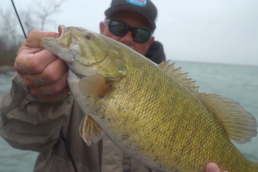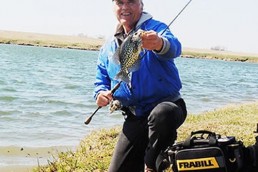When the Wind Cries…Listen
SHARE THIS POST
Over the winter months, a lot of my driving takes me past bodies of water. With everything white, looking at a frozen lake reminds me of a dead calm day during the open-water season. No ripples. No other water movement. Just calm. However, when the wind cries…listen.
In the past, I used to live for calm water, mostly for throwing surface lures at targets like stumps, laydowns, logs and surface weeds that hold soft-water bass. I hated the wind, because it made it difficult to position those baits perfectly near the best-looking parts of that bass-holding cover.
That is, until I started fishing a certain small lake, with mostly weeds for cover. When the fish were just about on shore during the spring, life was good. But I had a hard time getting any good action from the resident bass once the spawn ended and the water was calm.
That changed on one fall day when the wind kicked up. With the surface riled, I didn’t turn tail and run. Instead, I switched baits numerous times and finally got some largemouths going on shallow crankbaits along the weeds.
The next time out it wasn’t windy. And again, I couldn’t get anything going—until the wind picked up. Finally, it dawned on me. That was pretty much the way those fish operated. Not active until the wind blew. Then they woke up.
That approach has worked ever since. I now skip that lake (after the spawn) under calm conditions. But, give me a mild breeze and it’s one of the best waters I fish.
Basically, I think the chop on the water gives the fish a sense of security in clear water, and the waves hamper visibility. The fish take advantage of the cover the chop provides.
Ever since, I’ve felt better on the water with that little chop. I’m not saying to fish to fish certain waters no matter how hard the wind blows, because it can make fishing a lot more difficult. But I am 100% sold that certain levels of winds on certain bodies of water can turn a fishery on. When it does, it’s a joy to be there.
Another case in point. We were fishing a club tournament on a flowage. We came to a small island with a breeze blowing up on it. There was a bend in the river channel that swung in close to the island where the water went from 17 feet up to the island bank in a short distance. We caught one fish up shallow on our first circle. By the time we started a second pass, a good school of largemouths moved up and got really active. We took nine keepers over two more passes.
Are you enjoying this post?
You can be among the first to get the latest info on where to go, what to use and how to use it!
While all were caught on a 4-¼ inch Yum Vibra King Tube, it didn’t matter what color we used. I had six or seven color patterns of that basic tube, and we caught fish on every one. It was a weekend tournament, however, and the second day was calm and sunny. There wasn’t a fish to be had from the area we scored big on the day before.
Use the wind to your advantage. See which way it is blowing and pick the best-looking areas that it is blowing into. Most likely it is blowing plankton or other tiny food sources toward shore. That’s baitfish food. And the baitfish, in turn, are bass food.
While it might be easier to see how the wind affects fish on a lake, it can also work on rivers. Sometimes the wind blowing against the current can create small areas where the water goes slack and baitfish crowd in. Also, the wind can actually help push your boat upstream at times, or hold the boat stationary against the current, which can give you more time to fish pockets, wood cover or underwater points more effectively.
I always check the wind direction and force before I fish. Sometimes, that will tell you what bodies of water may be the most active. I’ve seen it do this on mid-lake shallow weed points and reed beds as well as shore areas. The fish group up and move to the edges to feed. However, be aware, if the wind shifts or decreases in force, those fish can move out just as quickly as they moved up.
It’s been a number of years since these “discoveries” began helping me put more fish in the boat. Although sometimes you are forced to fish bodies of water no matter how the wind is blowing (like on tournament day, as one example), I automatically look for the most likely areas that might hold fish in the wind. As you might expect from reading this, I have found that once the wind picks up and “cries,’ I find it’s time to listen.
Become a MidWest Outdoors Insider here!
MWO
SHARE THIS POST
Did you enjoy this post?
You can be among the first to get the latest info on where to go, what to use and how to use it!
Tom Luba
Tom Luba is a freelance outdoor writer living in New London, Wis. He has written about open water fishing for more than 35 years.



